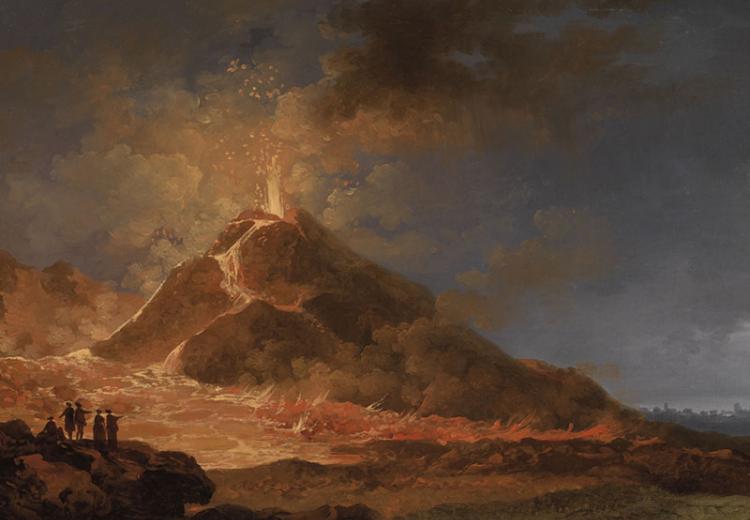Pompeii and the Eruption of Mt. Vesuvius

This painting represents the eruption of Mt. Vesuvius in 79 AD.
"… a devastation of the loveliest of lands, in a memorable disaster shared by peoples and cities."
-Pliny the Younger
Pompeii and the other ancient cities along the Bay of Naples that were destroyed by the eruption of Mount Vesuvius in 79 CE ignited the imagination of the Western mind when they were dug up in the eighteenth century. The excavation of so many well-preserved examples of Greco-Roman civilization helped inspire the intellectual movement known as the Enlightenment and an interest throughout the Western world in learning from the art and design, classical philosophy, political thought and literature of antiquity.
The area around the Bay of Naples was colonized by the Greeks as early as the 8th century BCE. Naples takes it name from the Greek word Νεάπολις (neápolis) for “new city.” In the first century BCE, the spectacular views of the sea around the bay attracted Romans: senators, other prominent citizens and later the emperors and their family. These elite Romans built lavish seaside retreats, called villas, along the bay in the shadow of the volcano where they could enjoy uninterrupted leisure, read and write, exercise, contemplate their gardens and the views, and engage in conversation with friends. For a brief introduction to this way of life watch the short video clip produced by the National Gallery of Art in conjunction with the exhibition Pompeii and the Roman Villa: Art and Culture Around the Bay of Naples.
Pliny the Younger's eyewitness description of the eruption of Mt. Vesuvius gives us a riveting sense of the impending doom Pompeii faced on August 24–25. You can find this letter and other teaching tools at the EDSITEment-reviewed website, the Pompeii Forum Project, a collaborative research venture formed to gather data about city life in Pompeii.
Pliny the Younger's letter, written to the historian Tacitus, notes how he and his family saw a "cloud … rising from a mountain-at such a distance we couldn't tell which, but afterwards learned that it was Vesuvius. I can best describe its shape by likening it to a pine tree. It rose into the sky on a very long 'trunk' from which spread some 'branches'… Some of the cloud was white, in other parts there were dark patches of dirt and ash." The ash and debris Pliny the Younger saw in that cloud would entomb the city of Pompeii for the next 17 centuries, protecting the Roman city from vandals, looters, and Mother Nature herself.
Systematic excavation of Pompeii did not begin until the early eighteenth century, when the discovery of some marble inscriptions by a farmer digging a well led to the excavation and unearthing of Pompeii and Herculaneum. These excavations yielded an archaeological gold mine: two small towns frequented by the Roman elite preserved in the moment of a typical summer day. When news of the discoveries of the ancient cities spread throughout Europe, curious tourists flocked to the Bay of Naples, attracted by the still-active volcano, Vesuvius. These excavations had a profound impact on ideas and tastes of Europe and America in the 18th and 19th centuries, giving rise to a new style of art and architecture called Neoclassicism.
You can take a virtual tour of these famous ruins through the new EDSITEment lesson plan, In Old Pompeii. In this lesson, students take a virtual field trip to the site and learn about everyday life in Roman times. After their "trip," they assume the role of amateur travel agents and create a travelogue designed to convince visitors to tour the city. Finally, students read excerpts from Mark Twain's description of Pompeii found in his best-selling book, Innocents Abroad, and then write the story of their own trip, modeling it on Twain's account.
Featured Lessons
Featured Websites
